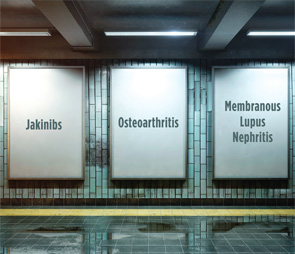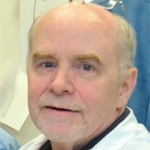
Image Credit: best pixels/shutterstock
CHICAGO—With the approval of the Jak inhibitors (i.e., jakinibs) tofacitinib and ruxolitinib—and others being investigated—rheumatologists need to arm themselves with an understanding of these drugs so they can think critically when evaluating them and deciding how to use them, said John O’Shea, MD, chief of the Molecular Immunology and Inflammation Branch of and scientific director for intramural research at the National Institute of Arthritis and Musculoskeletal and Skin Diseases.
Dr. O’Shea—a foremost expert on “Jaks,” or Janus kinases, who helped develop tofacitinib—spoke at the American College of Rheumatology’s 2015 State-of-the-Art Clinical Symposium in May, highlighting the history of Jak development and questions that have yet to be answered as the field moves forward.
His talk led off a session on The Big Three, which also included talks on osteoarthritis and the impact footwear can have on knee inflammation; and membranous glomerulonephritis treatment in systemic lupus erythematosus.
Jakinibs
Jaks—four of 518 protein kinases—are phosphotransferases that bring about the transfer of ATP to cytokine receptors, which allows cell signaling molecules, such as STAT proteins, to be recruited. Jak inhibitors block this ATP binding and prevent receptors from transmitting signals.

Dr. O’Shea
Approved jakinibs—ruxolitinib, which targets Jak1 and Jak2, and is approved for polycythemia and myelofibrosis; and tofactinib, which targets Jak1 and Jak3, and is approved for RA—will likely soon be joined by others. Drugs that target Jak1, along with others, are in development.
“Jakinibs are a reality—many more to come,” Dr. O’Shea said.
Dr. O’Shea said that it’s important to understand that when a drug inhibits the Jak/STAT pathway, multiple cytokines are being inhibited, and the clinical upshot of that scope of inhibition is not yet known. He said it isn’t clear yet whether this multiple-cytokine inhibition is the reason why toficitinib and baracitinib work. And, if a second generation of Jak inhibitors is more selective, he said, it isn’t known whether they will work as well or have a better safety profile.
“The things you should be asking yourself as you’re looking at posters at the ACR [Annual Meeting] are which Jak is being inhibited? What other kinases are being inhibited? The scientific question[s] really [are], ‘What is the basis of efficacy? Which cytokines? Which ones are really important in which cells?’”
Dr. O’Shea said that when jakinibs were first being developed, the prevailing idea was that a drug that blocks ATP would have “this exquisite specificity.” But it turns out that the 20 or so approved kinase inhibitors have varying levels of specificity.
The impact of the half-lives of Jak inhibitors isn’t well understood. “We’re in the generation of small molecules again,” Dr. O’Shea said. “We’ve been thinking about biologics for so long. But small molecules have varying half-lives and that’s relevant for drugs like tofacitnib and baracitinib. So we need to be thinking about … how long [we’re] going to be inhibiting each of these Jaks.”
A key question that needs to be answered is how to get the maximum benefit with the fewest side effects.
“Are we treating patients in the optimal way with the right schedules of these drugs?” Dr. O’Shea said.
In a trial of oclacitinib, a Jak inhibitor approved for itching in dogs, researchers used a tapering schedule, with big doses at the outset and then a taper—which Dr. O’Shea noted has not been done in a human trial. “What’s the optimal dose of a Jak inhibitor for any given patient? I think that’s someplace where we can do more work in the future.”
Jakinibs come with concerns about infections and whether they increase risk of tumor growth. With the wide scope of kinase inhibition, Dr. O’Shea said, it might seem that the side effect risk is worse than it is. But because Jaks are present in only one of the seven “cytokine receptor superfamilies”—cytokine receptor Types I and II—jakinibs leave a lot of signaling undisturbed.
“You’re inhibiting a number of Type I/Type II cytokine receptors, and the good news is that that might be contributing to the efficacy [of treatment] in rheumatoid arthritis,” Dr. O’Shea said. “And the reason you don’t have more infections is that you have the possibility to signal through all these other cytokine receptors to preserve some degree of immune homeostasis.”
Pain in OA
Najia Shakoor, MD, associate professor of medicine of rheumatology at Rush University Medical Center, who has studied pain and biomechanics in osteoarthritis, said the subject of pain in OA is still vexing.
Dr. Shakoor said she is perplexed when a patient with severe disease comes to her office but reports very little pain, but another with only slight changes on X-ray reports a lot of pain.
“The problem is, we still don’t truly understand what causes pain in osteoarthritis,” Dr. Shakoor said. “This is a huge area of research in osteoarthritis today.”
A fairly new development, Dr. Shakoor said, is that OA has started to be thought of as a chronic pain condition, with factors similar to other chronic pain diseases, including “central sensitization,” in which the central nervous system “takes over,” perpetuating pain. This idea could play a new role in trying to treat OA.
Over the past several years, not many new pharmacological interventions have been introduced. Duloxetine has been shown in trials to improve pain and function significantly compared to placebo, and is a good option for some patients, Dr. Shakoor said.
“I find duloxetine very useful in my patient population,” she said. “I’ve had some really great success with it. It’s a great option for patients who may have OA plus fibromyalgia or spinal stenosis and neuropathy and a great addition to other agents we might be using to treat their pain.”
Topical nonsteroidal antiinflammatory drugs (NSAIDs) have also come into use, demonstrating less than 5% of the concentration in plasma of that seen in oral NSAIDs. They might be a good option for patients for whom physicians are reluctant to prescribe long-term oral NSAIDs.
When a drug inhibits the Jak/STAT pathway, multiple cytokines are being inhibited, & the clinical upshot of that scope of inhibition is not yet known.
But Dr. Shakoor emphasized the importance of nonpharmacological interventions as well—not just physical therapy, but also exercise and weight management. She has studied the biomechanics of the knee joint extensively and suggested that interventions lessening the load on the knee joint could help delay disease progression.
Some movement and force on the joint are necessary for nutrients to be distributed, but too much force can lead to degeneration and damage.
“We believe it’s these forces when you’re moving every day and ambulating that are really important in terms of OA process and degeneration,” Dr. Shakoor said.
The “peak external knee adduction moment,” measured through gait analysis, is a primary predictor of load over the medial compartment of the knee and is associated with OA severity progression.
“[Because] this is associated with OA progression, if we can actually lower this load, we may be able to delay progression of osteoarthritis,” Dr. Shakoor said. She added that this is not yet proven, but is the main motivation behind her study in this area.
A brace—the valgus/unloading knee brace—can be one way to lessen these loads, although many patients find it too bulky and cumbersome.
Studies have found that bulky shoes that insulate the foot put more load on the knee joint, likely because they insulate the foot from the footfalls and because there is less use of the body’s natural reflexes to lessen hard impact.
Her lab has found that a flatter, lightweight shoe called a “mobility shoe”—with cuts in the sole to mimic the natural bends of the bare foot—brought about a 17% reduction in knee joint loads in six months compared with subjects’ usual shoes. A similar lightweight shoe is being studied in Italy and elsewhere.
“Not all of this footwear is available,” Dr. Shakoor said. “I tell you this so that you have an idea about how to think of biomechanics. When your patients ask you about recommendations, … then maybe you’ll have at least some evidence” and could recommend a lighter, more flexible shoe, keeping in mind a patient’s possible foot conditions.
Glomerular Nephritis

Dr. Ramsey-Goldman
Rosalind Ramsey-Goldman, MD, DrPH, Solovy Arthritis Research Society Professor of Medicine at the Northwestern University Feinberg School of Medicine, said membranous lupus nephritis (MLN) is important for clinicians to watch for and treat. End-stage renal disease is all too common for these patients.
MLN is characterized by subepithelial immune deposits along peripheral capillary loops with glomerular capillary wall thickening, and podocytes on the outside of the glomerular basement membrane as the target of the autoimmune response.
If the podoctye is damaged, “it can alter the internal milieu,” Dr. Ramsey-Goldman said, with additional antigens and autoantibodies that can bring about progressive disease. So it’s important to stop the initial insult.
There are some differences between membranous and proliferative lupus nephritis—hypertension and certain serologic markers are more common in the proliferative type—but the similarities are such that a kidney biopsy is needed for a definitive diagnosis, Dr. Ramsey-Goldman said.
The ACR guidelines on LN treatment call for hydroxychloroquine for all patients with LN, along with blood pressure control, statins for hyperlipidemia, angiotensin inhibition for those with proteinuria of more than 0.5 gm per day, and counseling on contraception and pregnancy risks.
A meta-analysis published in 2011 found that the rate of either complete or partial response for steroids along with a nonsteroidal immunosuppressive treatment was 81%, but for steroid-only treatment, it was 60%.1 “This would suggest that adding something to steroids would be helpful,” Dr. Ramsey-Goldman said.
Another study out of the National Institutes of Health casts doubt on this. Although prednisone plus intravenous Cytoxan, as well as prednisone plus cyclosporine, showed better remission rates after one year, patients in the Cytoxan group also were more likely to relapse, and “pretty quickly,” after that first year.2 Dr. Ramsey-Goldman said this study is notable in that it is the only one with follow-up long enough to show relapse.
In a look at the most recent literature on LN, Dr. Ramsey-Goldman reviewed a 2015 study comparing tacrolimus and mycophenolate mofetil (MMF) as induction therapy. They both showed improvements over six months in urine/protein creatinine ratio, but without differences between the arms.3
In another recent study, multitarget therapy of tacrolimus, MMF and steroid was compared with IV Cytoxan and steroid as induction therapy. After 24 weeks, 83% of those in the multitarget group achieved a response, compared with 45% in the IV Cytoxan group.4 Both of those, she noted, don’t have sufficient follow-up to assess relapse risk.
MLN is important to treat, Dr. Ramsey-Goldman said, because of the serious risks involved. Up to 20% of patients develop chronic kidney disease, and end-stage renal disease develops in 8% to 12% of patients after seven to 10 years. Some 14% of patients have end-stage renal disease or die by five years, and 28% in 10 years.
These figures demonstrate the need for prompt and effective treatment, she said.
Thomas R. Collins is a freelance medical writer based in Florida.
References
- Swan JT, Riche DM, Riche KD, et al. Systematic review and meta-analysis of immunosuppressant therapy clinical trials in membranous lupus nephritis. J Investig Med. 2011 Feb;59(2):246–258.
- Austin HA 3rd, Illei GG, Braun MJ, et al. Randomized, controlled trial of prednisone, cyclophosphamide, and cyclosporine in lupus membranous nephropathy. J Am Soc Nephrol. 2009 Apr;20(4):901–911.
- Mok CC, Ying KY, Yim CW, et al. Tacrolimus versus mycophenolate mofetil for induction therapy of lupus nephritis: A randomised controlled trial and long-term follow-up. Ann Rheum Dis. 2014 Dec 30; pii: annrheumdis-2014-206456.
- Liu Z, Zhang H, Liu Z, et al. Multitarget therapy for induction treatment of lupus nephritis: A randomized trial. Ann Intern Med. 2015 Jan 6;162(1):18–26.


